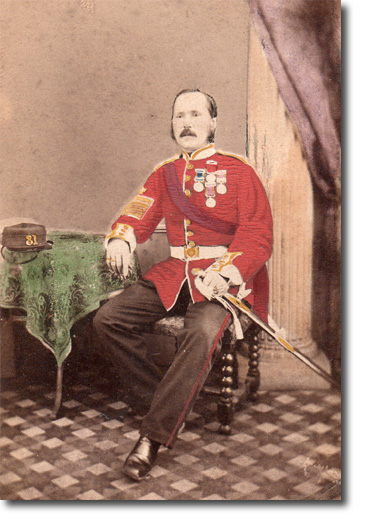|
|

 |
|
This photo was kindly sent to us by Terry Rogers who was only able to tell us that the photo was
Taken in Aldershot 1880-1900. But the infantry full dress tunic that the man wears was in use for
about ten years prior to 1868 when it was replaced with one that did not have the distinctive slash cuffs seen here.
Since the regiment was raised, in 1702, the facings colour, ie collar and cuffs, was buff which sometimes appeared very pale, almost white. George II dubbed them the Young Buffs at Dettingen in 1743. They retained this colour until 1881 when they were joined with the 70th Foot to become the East Surrey Regiment. Then the facings became white. This is a retouched photo, originally monochrome but coloured by hand. The colourist was correct to show 'gold' buttons and lace. The colour of the medal ribbons may not be so accurate. These could date as far back as The First Sikh War (1842-46) and include the Crimean War (1854-5) and the Second China War (1857-60). The rank chevrons were worn on the right arm only at this time. Sergeant-majors had four gold stripes with a crown over them. His rank also allows him the wearing of a sword. Sergeants and above wore a crimson sash over the right shoulder (officers wore it on the left shoulder). He has obligingly placed his cap on the table with the regimental number 31 clearly on the front. This is an undress forage cap which could be worn with full dress. On parade he would have worn a full dress shako with a red and white pom-pom on the front. |
31st Regiment of Foot Uniforms
Armed Forces | Art and Culture | Articles | Biographies | Colonies | Discussion | Glossary | Home | Library | Links | Map Room | Sources and Media | Science and Technology | Search | Student Zone | Timelines | TV & Film | Wargames
